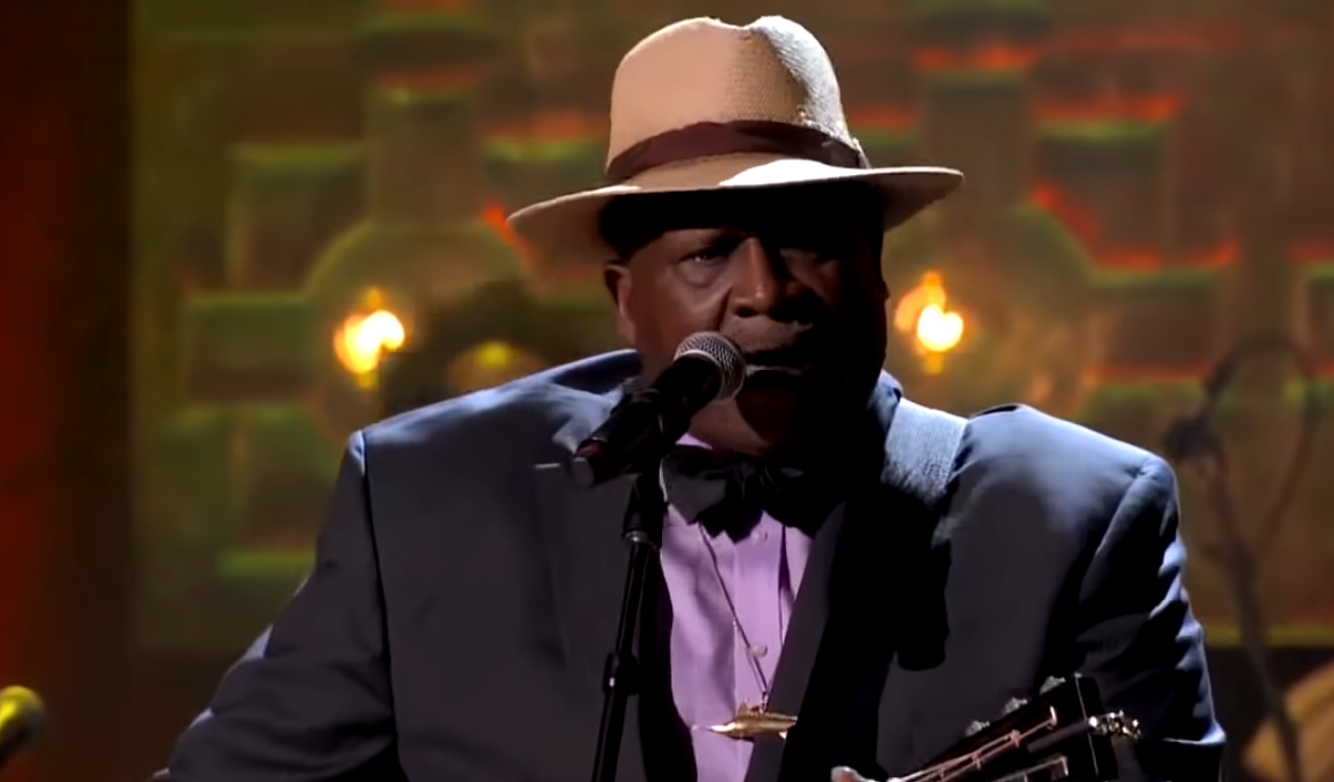New York, Radio City Music Hall, February 1998. The 40th anniversary Grammy Awards was one of the most eventful music shows of the year.
As Best Album of the Year author Bob Dylan was performing his song “Love Sick,” a man burst onto the stage with “soy bomb” written on his chest. The confusion he caused, however, could not obscure the greatness of the music that night.
That same night, The Smashing Pumpkins for “The End Is the Beginning Is the End”, Fiona Apple for “Criminal” and The Wallflowers for “One Headlight” received their well-deserved awards.
The same ceremony later featured a long undeservedly overshadowed musician, Taj Mahal, who finally managed to break the long-awaited ovation. He was 55 years old at the time, and this was his first Grammy.
His album “Senor Blues” won first place for Best Contemporary Blues Album. An unforgettable moment for a man who has dedicated his life to working with the blues sound and creating several new blues styles. Especially when you consider how much and how long he was criticized for his musical experiments.
Chances are you have a question like this, “What is an article about a bluesman doing on a rock music website?” The answer is simple – at one time, Taj Mahal was a musician who played not only blues, but also rock and roll. In addition, he was friends and communicated a lot with famous rock musicians (you’ll see their names while reading the article). Not many people have heard of him in our area and I sincerely think, that it is unfair. Anyway, read on and you will understand!
Taj Mahal and the musicians of the rock scene
He was never your average bluesman. He grew up in Harlem, in a family with Caribbean roots. He got to the heart of the blues in the ’60s, and then started digging even deeper and pulling out the hidden connections that connected Afro-Caribbean folk, rhythm and blues, gospel, African and Latin American music.
One-third tradition keeper and two-thirds experimenter, Mahal may be the first American musician to play ethnic music before the term itself existed.
One of the first to become interested in the new sound was Eric Clapton. In his autobiography he writes that he accepted Mick Jagger’s invitation to participate in his show “The Rolling Stones Rock & Roll Circus” in 1968 (as part of the supergroup The Dirty Mac) mainly because he wanted to meet Mahal.
Keith Richards, who had previously performed with Mahal and Graham Parsons in Los Angeles, admitted that Taj showed him some new tricks, adding that: “His arsenal was to be envied, it always was.”
At this concert, Taj Mahal was the musician solely representing the black American blues, music the Stones adored. This show was filmed, and the material was to be made into a musical film.
There was footage of Taj Mahal, the musician with a badass outfit: a wide-brimmed hat, a red scarf around his neck, a smart leather jacket. He looked just as good as the other stars invited to the show – Clapton, Lennon, and many others. That’s how he was – the hippest of the hippies.
Tudge’s long struggle for recognition
Back in the States, Mahal quickly and easily recorded his next album, The Natch’l Blues, which expanded his musical palette: he included two soul covers on the record. Pianist Al Cooper and former Little Richard drummer Earl Palmer contributed to the record.
In 1969, the semi-acoustic double-play Giant Step/De Ole Folks At Home was released – it was Mahal’s first album to reach Billboard magazine’s top 100. Yet Taj Mahal was a consistently obscure musician, unlike Frank Zappa and Led Zeppelin, who were in the top 100.
Mahal continued to ride the waves of music freely. In 1971 he recorded an album of West Indian calypso songs, Happy Just To Be Like I Am, and in 1974 Mo’Roots came out – the result of exploring the links between blues and Jamaican reggae. One of the guest musicians was The Wailers bassist Aston Barrett, and he played a cover of one of the songs by his own band Slave Driver.
But Mahal’s pluralism was not to everyone’s liking. Record sales were far from what they should have been, and he stopped working with Columbia and signed with Warner Bros. in 1976.
The three subsequent albums recorded with the new label did not change the situation.
The next three albums, already recorded on a new label, did not change the situation.
By the end of the ’70s he was out of contract. “I would have loved to do just blues and R&B – writing my own songs and interpreting existing ones,” he explains. – But nobody wanted to work with me.”
Then Taj Mahal moved to Hawaii and started recording albums for kids.
The next album (“Taj,” 1987) didn’t come out until a decade later. But he didn’t fully resume his relationship with the music industry until the early ’90s.
Success at last
Mahal found a home on a new label, Private Music, co-founded by former Tangerine Dream member Peter Bauman. This allowed him to rediscover his unique blues groove – the Phantom Blues album (featuring Eric Clapton and Bonnie Raitt) was released in 1996.
His third release on that label, Senor Blues, won him a Grammy (“The main achievement was that now people had to listen to that album,” he says).
Another Grammy went to his live album, Shoutin’ in Key.
But that was far from the pinnacle of his fame. Taj Mahal received wider recognition as a versatile musician in 1999 when his CD “Kulanjan” was released – a collaboration with the Malian musician Toumani Diabate, who played a folk instrument – kora.
Here Taj acted as a true innovator in the field of music, crossing West African melodies with primitive blues.
“I really wanted people to hear this music,” says Mahal, “Kulanjan allowed me to go back in time and hear the voices of my ancestors. After recording the album, I felt I could no longer play guitar. I could keep just my bark and that would be more than enough for me.
Mahal’s triumphant return didn’t end there. His influence can be felt in the music of the next generation of American bluesmen – free-spirited and unconstrained musicians such as Eric Bibb, Alvin Youngblood Hart, Gary Clark Jr. and Keb Moe. The latter has called Taj’s performances an inspiring revival:
Taj Mahal is a musician who is the most shining example of a man who has always known who he is and what his life is all about.

